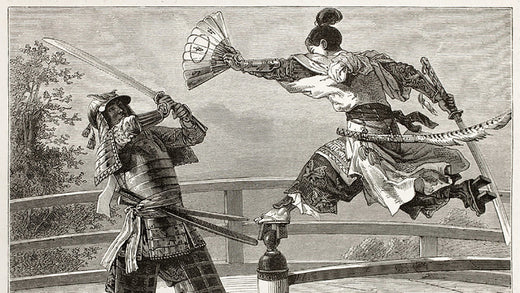What Is Samurai Sword? Unveiling Japan's Iconic Warrior Weapon

Samurai Sword Fights: What Is a Samurai Sword? Unveiling Japan's Iconic Warrior Weapon
What is samurai sword fighting called?
The samurai sword, also known as a katana, is one of the most iconic weapons in history, symbolizing the valor and precision of Japan's warrior class. Crafted with unmatched artistry, the katana is designed for both beauty and deadly efficiency, making it the weapon of choice for samurai fights. With its curved, single-edged blade and exceptional sharpness, it was used in various techniques, including swift, decisive cuts during battle. The katana's balance and flexibility allowed samurai to engage in samurai sword fights with incredible speed and skill, making it a symbol of not just physical strength but also discipline, strategy, and honor. Beyond its role in combat, the samurai sword represents the deep spiritual connection between the warrior and their weapon, embodying the spirit of Bushido, the way of the warrior.
How was the iron sword effective during ancient times?
In the century BC, the transition from carbon to iron marked a significant shift in weaponry, greatly impacting combat strategies. Early iron swords were more durable and sharper compared to their bronze counterparts, making them a valuable asset for warriors. The introduction of iron allowed for the development of stronger, more reliable weapons, enabling more precise strikes and longer-lasting blades. This evolution of material technology reshaped the dynamics of warfare, giving rise to more efficient and powerful weapons, such as iron swords, that played a pivotal role in the success of ancient civilizations.
What Is a Samurai Sword? Unveiling Japan's Iconic Warrior Weapon
A samurai sword, particularly the katana, is one of the most iconic weapons in history. Known for its curved, single-edged blade, the katana was meticulously polished to achieve a razor-sharp edge. Samurai, the feudal lords and warriors of Japan, relied on these blades for both close combat and ceremonial purposes. The curved blade design allowed for smooth and efficient drawing the sword and quick strikes in battle. For centuries, the samurai sword has been a symbol of strength, discipline, and honor, representing a long time tradition of Japanese craftsmanship and warrior culture.
What Is Samurai Sword? Unveiling Japan's Iconic Warrior Weapon
how was the iron sword effectinve?
According to popular saying, the samurai sword is not only extremely sharp, but also can easily win even it's against armor. But in fact, all weapons of the katana can't let people who wear iron armor blood splatter on the spot or even split in half with one swing through just like the movie and animation works shows.
We need to know that no matter what kind of armor is, it has a thick lining as a soft cushion to make sure the kinetic energy of the strike can be absorbed, rather than be transmitted to the body. Although iron armor needs toughness, which causes its hardness is slightly lower than the blade, but it is still made of steel after all, even it's a sharp samurai sword, it is impossible to split the armor or even split people who wear iron armor in half.
The Effectiveness of Swords in the Bronze Age
Before the advent of iron and steel, the Bronze Age marked a pivotal era in the development of weaponry, including the evolution of blades. Bronze, an alloy of copper and tin, was the primary material for tools and weapons during this period, offering advantages in sharpness and durability over earlier stone weapons. However, like the iron katana that followed, bronze katana had limitations when facing armored opponents.
Bronze Swords and Armor
Bronze swords were effective for slashing and thrusting, especially in battles where armor was less sophisticated or absent. During the Bronze Age, armor was typically made of leather, padded fabric, or bronze plates, which were lighter and less durable compared to the iron or steel armors of later periods. Against these materials, bronze katana proved formidable, capable of penetrating or slashing through the defenses of lightly armored adversaries.
1. In Japanese history, there were also real incidents of samurai swords fighting iron armor
In the famous Ikedaya incident in Bakumatsu, ten members of the newly selected group put on Chainmail that the Japanese called "Roqku Ashi" to suddenly attack nearly thirty Sonnō-jōi warriors. As a result, none of the mission new group members was killed, and there were many good swordsmen among the Sonnō-jōi warriors and some of them even carried their famous family katana, but there were 7 people of them died and 11 people of them were seriously wounded, while the newly selected group fought more with less but no one was killed. Thus it can be seen that the Japanese katana does not have the properties of breaking armor for iron armors.

2. During the Japan Muromachi period, there was a popular type of samurai swords called 'Gaisou'
The name sounds like it's an armor-busting knife that can pierce armor. In fact, the knife is usually worn on the right arm, which is used for thrusting with the left hand after drawing close to the enemy. It is not used for directly piercing the armor, but stabing the underarm, face, and other parts of the body that armor can't protect by a short knife instead. After all, as long as the armor can move, there have to leave space for the movement, and can't protect all sites of the body. In a word, this is a dagger specialized in sneak attacks on gaps.
In fact, the research shows that on a real battlefield, high quality battle ready katana is actually just a weapon, not the main battle weapon on the battlefield. Suzuki Shinya, a Japanese scholar, once counted the records of the 'letter of military loyalty' used by 1729 warriors to report their battlefield achievements to their masters during the Sengoku period.
3. Samurai swords are really very sharp while against targets without armor
Japan has had the tradition of chopping a rolled up straw mat to test the cutting method and the sharpness of the katana all the time, because the Japanese believe that the density and feel of rolled up straw mats are very close to that of human limbs, they use straw mats as test objects to simulate chopping human bodies.
In the same way, many people now use pigs to test the cutting power of knives. In the test, samurai swords can even cut four pigs at once. These tests have proved that the cutting power of samurai swords to against targets without armor is beyond of doubt. However, this result also reveals that the main function of katana is not a weapon of war on the battlefield, but a weapon for daily self-defense and knife fighting.
So, rumors are just rumors after all, and the katana itself is just a weapon that represents Japanese culture. The appreciation of rational science is the true kingcraft.

